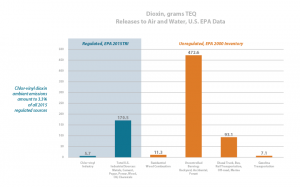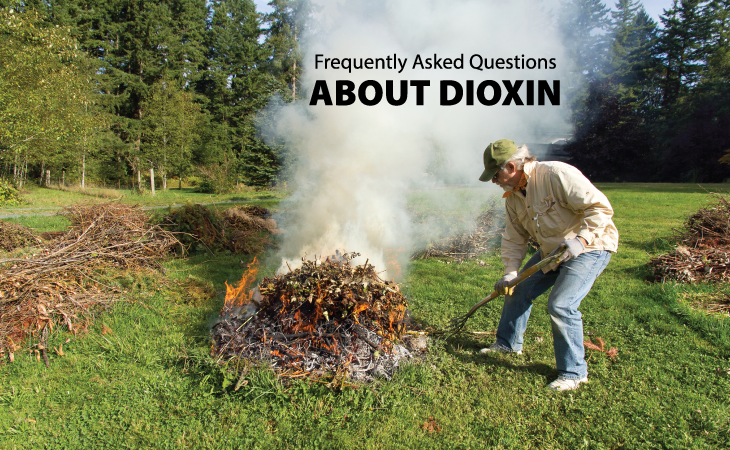This website uses cookies so that we can provide you with the best user experience possible. Cookie information is stored in your browser and performs functions such as recognising you when you return to our website and helping our team to understand which sections of the website you find most interesting and useful.
News
Frequently Asked Questions About Dioxins
We occasionally receive questions about dioxins from architects and designers. It’s one of those words that people find very scary – and reasonably so. Based on laboratory animal studies, dioxins have the potential to cause cancer, reproductive and developmental problems, and damage to the immune system.
Almost every living creature has been exposed to dioxins or dioxin-like compounds.
Today people are exposed to dioxins primarily by eating food, in particular animal products, contaminated by these chemicals. Dioxins are absorbed and stored in fat tissue and, therefore, accumulate in the food chain. More than 90 percent of human exposure is through food, mainly meat and dairy products, fish and shellfish.1 Very little exposure comes from manufacturing – and an even tinier amount is attributable to the vinyl industry.
While dioxins are a health concern, they’re largely not a building materials or interior products health concern because human exposure overwhelmingly comes from the food we eat.
What are dioxins?
Dioxins are a family of chemicals that are a byproduct of incomplete combustion when halogen-containing substances are present. Halogen-containing substances include common table salt (sodium chloride) and common farmland nutrients (potassium chloride). With incomplete combustion of organic materials in the presence of halogen-containing substances and compounds, chemical compounds – including dioxin – have the potential to be emitted. Even common materials such as wood can produce dioxins during incomplete combustion. Think, for example, of the leftover pieces of logs in your fireplace or the remnants in your backyard fire-pit. Both are examples where the fire wasn’t hot enough to incinerate everything. In a larger scenario, a forest fire likewise results in incomplete combustion.
If you visualize dioxin as being in small airborne particulate matter like soot, it comes out of a fire and into the air. It lands on the ground and can end up in groundwater and in vegetative growth. Cows and chickens and other livestock eat from the ground and absorb dioxin. Dioxins do not break down easily so they accumulate in animals in fatty tissue– and then in our bodies as well once consumed in certain foods.
Where do dioxins emissions come from?
Manufacturing sources of dioxin include diverse industries, such as metals, wood, brick, concrete, chemicals and plastics, petroleum refining, and certain combustion-type power generation.
Strict regulatory controls on these major industrial sources of dioxin have reduced emissions into the air by 90 percent, compared to levels in 1987.2 According to the National Institute of Health, dioxins are produced through a variety of incineration processes, including improper municipal waste incineration and burning of trash in addition to being released into the air during natural processes, such as forest fires and volcanic eruptions. Exhaust from diesel and gasoline engines, and smoke and ash from wood-burning fireplaces, have also been shown to contain dioxins.3 Cigarette smoke also contains small amounts of dioxins.4 Even fireworks displays produce dioxins.5

According to 2014 Environmental Protection Agency (EPA) Toxic Release Inventory (TRI) data, 4.5 grams of toxic equivalent (TEQ) of dioxin released into the air and water came from the chlor-vinyl industry. Contrast that to the 190.2 grams TEQ released to air and water from all U.S. industrial sources during that same period– and 472.6 grams TEQ of dioxin estimated by the EPA for its 20066 Dioxin Assessment released into the air from the combination of forest fires and backyard burning events.
The vinyl industry has significantly reduced its ambient environmental (air and water) dioxin emissions over time. In fact, based on the EPA’s Toxic Release Inventory reports, dioxin ambient emissions to air and water from the chlor-vinyl chain have been reduced by 87 percent during the period 2000–2014.
Why is there so much focus on dioxin?
Back in the 1970s, dioxin levels peaked, and prompted new safeguards and regulations to be put in place to reduce dioxin levels in the United States. At the same time, vinyl manufacturers along with those in other industries started to tackle the problem with new technologies and new environmental controls. Much progress has been made in reducing manmade exposures over the past 40 years.
Indeed, the National Institute of Environmental Health Sciences says that “the extent of the hazard has diminished in the U.S. as environmental controls significantly reduced the introduction of new industrial sources of dioxin.”7
- EPA website: https://www.epa.gov/dioxin/learn-about-dioxin, accessed Dec. 13, 2016
- Dioxins, National Institute of Environmental Health Sciences, June 2012, https://www.niehs.nih.gov/health/materials/dioxins_new_508.pdf
- An Inventory of Sources and Environmental Releases of Dioxin-Like Compounds in the United States for the Years 1987, 1995, and 2000, US EPA, November, 2006
- https://www.epa.gov/dioxin/learn-about-dioxin
- Schmid P., et.al., Releases of chlorobenzenes, chlorophenols and dioxins during fireworks. Chemosphere. 2014 Nov;114:158-64. doi: 10.1016/j.chemosphere.2014.03.088. Epub 2014 May 14.
- Ibid. 3
- Ibid. 2


